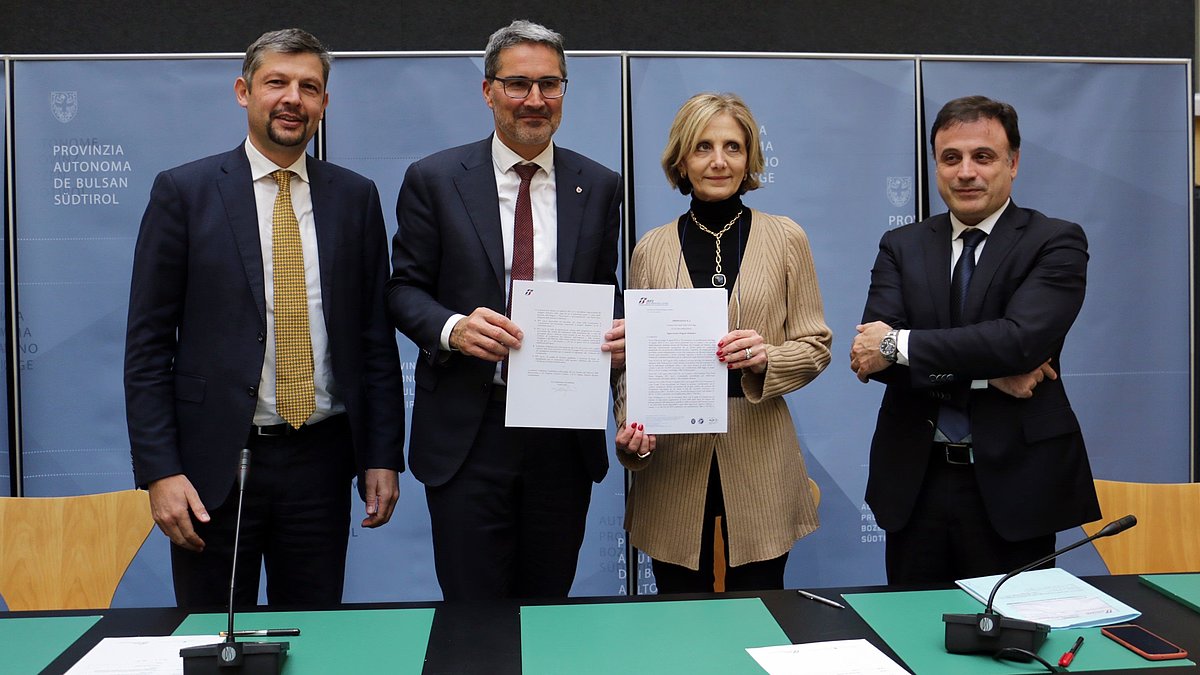With the definitive project approved and signed by the provincial government and RFI, now nothing should stand in the way of the new train route through the Val Riga/Riggertal valley.
The construction of the Val Riga/Riggertal valley route, a 3.8 km direct railway connection between Sciaves/Schabs and the Brennero/Brenner railway line, is moving closer by the day: An agreement has now been reached between the government of South Tyrol, represented by Governor Arno Kompatscher, and the Italian government’s Extraordinary Commissioner Paola Firmi, who is also the Deputy Director General of Development and Standards at rail network operator RFI. Firmi signed the decree approving the final project design on 1 December in Bolzano/Bozen. Work is now expected to start in the summer of 2023. Some EUR 200 million will be invested in the project, which is partly financed with funding from the Italian National Recovery and Resilience Plan (PNRR).
Among those present at the official signing were South Tyrol Minister for Mobility Daniel Alfreider, RFI representative Giuseppe Romeo alongside representatives from the municipalities involved, Martin Vallazza, head of the Provincial Government’s Mobility Department, and Joachim Dejaco, Director at STA – Südtiroler Transportstrukturen AG/Strutture Trasporto Alto Adige SpA –, as well as Martin Ausserdorfer, the Director of the Brenner Base Tunnel Observatory.
Mobility policies: putting citizen needs at the centre
“Our mobility policies have always been geared towards aligning public transport with the needs of our citizens”, Governor Kompatscher explained. This included, he continued, reducing travel times as well as offering a tightly scheduled timetable.
RFI plans to further promote rail travel
“The approval of the finalised design for the Val Riga/Riggertal valley is a key step towards implementing the project and connecting the railway line between San Candido/Innichen and Fortezza/Franzensfeste to the pivotal rail axis running from Brennero/Brenner to Verona in a crucial section,” as Extraordinary Commissioner Firmi stressed, adding: “The new train connection not only ensures shorter travel times between Rio di Pusteria/Mühlbach and Bressanone/Brixen – it is also part of the functional mobility infrastructure envisioned as part of Italy’s bid for the 2026 Winter Olympics in Milan and Cortina d’Ampezzo.”
Passenger benefits
South Tyrol Mobility Minister Alfreider: “The new infrastructure will save passengers some 15 minutes of travel time. Plus, they will no longer have to change trains, especially when travelling to the Pusteria/Pustertal valley from Bolzano/Bozen.” Alfreider added that the plan was to introduce services at a semi-regular 15-minute interval between Bolzano/Bozen and Bressanone/Brixen, along with direct connections between Bolzano/Bozen and the Pusteria/Pustertal valley. “And with two new stops in Varna/Vahrn and Naz-Sciaves/Natz-Schabs, even more passengers will have access to the railway”, he concluded.
Together with other railway developments throughout South Tyrol, this project is important for creating a timetable governed by regular intervals – in other words, even more coordinated mobility at a fixed rhythm.
Short cut by bridge and tunnel
With a total length of almost four km, the planned line will run through an 800 m tunnel underneath the A22 Brennero/Brenner motorway and the almost parallel SS 12 state highway, then cross the Isarco/Eisack river on a 172-m-long arched bridge before entering the Pusteria/Pustertal valley, where it will run alongside the SS 49bis state highway for one km and then connect to the existing railway line by means of a 350 m tunnel and, finally, the new station in Naz-Sciaves/Natz-Schabs.
Photo: LPA/ Dejaco
